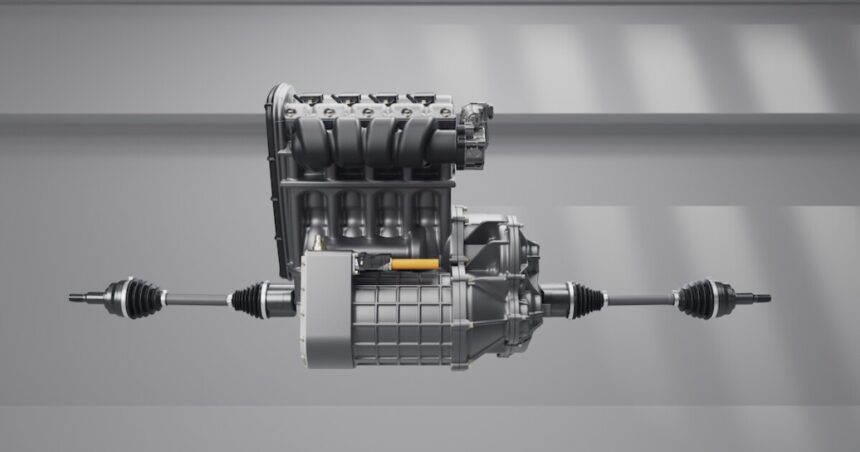Automakers are putting the brakes on ambitious all-electric vehicle expansion plans of recent past, increasingly pursuing multiple powertrain technologies for cutting emissions across their global lineups. Horse Powertrain is ready to lend a hand, putting its expertise in both electric motor and ICE technology into an all-in-one fuel-electric drive it calls the Future Hybrid Concept. The visionary setup looks to seamlessly blend battery and fuel propulsion into a single drive unit that easily transforms a pure-electric car into a flexible hybrid.
While battery electric vehicles (BEVs) ultimately bounced back from a sluggish start to 2024, their growth still slowed significantly during the year, acquiescing some market momentum to gas-electric hybrids.
In the US, for instance, electric vehicle sales surpassed 1.3 million, a 7.3 percent increase from the 1.2 million units sold in 2023, according to Cox Automotive sales data. That seems a nice gain on the surface but represents a significant year-over-year drop-off from the 49 percent sales growth experienced between 2022 and 2023.
Hybrids (including plug-ins), meanwhile, outpaced EVs in the US to sell over 1.8 million units in 2024, according to data from Edmunds, a 30 percent increase over 2023 numbers. Hybrids had an 11 percent market share in 2024 compared to an 8 percent share for EVs.
The results were even more pronounced in Europe, where hybrid registrations grew by 21 percent while EV registrations experienced their first decrease in years, dropping by 1.2 percent, as tracked by JATO Dynamics. EVs had an accompanying small dip in market share while hybrids gained share.
Automakers have responded to the surging popularity of hybrids versus EVs by increasing current hybrid production levels and revising electrification roadmaps away from BEV-focused plans and toward a wider selection of lower emissions powertrain options.
Horse was essentially created around this principle as a joint venture between Renault and Geely spun off in 2023, developing cleaner next-generation internal combustion engines and hybrid powertrains that can neatly integrate into automakers’ global net-zero strategies. This week, the company is looking beyond current technologies to preview a powertrain of the future.
Named concisely the Future Hybrid Concept (FHC), the design looks to make it easier for automakers to shift from all-electric to hybrid electric vehicle offerings. In fact, the compact drive is designed to integrate directly into existing BEV platforms with minimal modification. This would allow automakers to offer a hybrid version of an EV without investing in a costly new platform or production tooling.
Horse Powertrain
Horse installs an electric motor, internal combustion engine, transmission and electronic control hardware into the single compact FHC unit that mounts directly to the vehicle’s subframe in place of a front-mounted BEV electric drive. In this way, automakers can integrate it directly into existing BEV architecture in order to offer a hybrid solution, either as an alternative to or replacement for the all-electric model.
The Future Hybrid Concept does not include its own battery, instead using its ICE as a range-extender generator for the existing battery in the BEV platform. The electric motor can operate on its own to deliver drive power or in parallel with the engine, and the system is also meant to work within an all-wheel-drive layout. It includes an onboard charger and 800-V booster for fast-charging the vehicle battery.
“For over a decade, it looked like battery electric vehicles were the only path to net zero and OEMs planned accordingly,” Horse CEO Matias Giannini said. “However, we’re now shifting toward a technology-neutral world, with different markets and applications each pursuing their own sustainable mobility journey. Our Future Hybrid compact, integrated powertrain concept allows OEMs to offer powertrain diversity with minimal disruption to production process and resource expenditure.”

Horse Powertrain
In addition to working within BEV architecture, the FHC drive is designed to drop into existing ICE platforms, automatically improving emissions and efficiency performance over the original ICE powertrain. The east/west orientation is configured to meet global safety and crash standards.
Adding even more efficiency-boosting flexibility, the Future Hybrid Concept’s engine can run on a variety of fuels, including gasoline, ethanol flex fuels, methanol and synthetics, providing a versatile platform for operations in markets around the globe. Horse has also future-proofed the compact design so it can work seamlessly with anticipated next-gen components like automotive heat pumps and R290 refrigerants.
Horse gives the world its first look at the Future Hybrid Concept at the 2025 Auto Shanghai show. It’s less a fanciful visionary concept and more a production preview, with Horse planning to install it in the first road-going vehicles as early as 2028.
Source: Horse Powertrain










